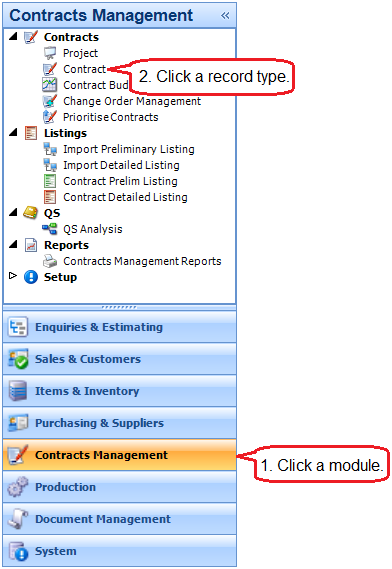

The following instructions tell you how to find and open a record for editing. If you carry out the instructions and there are still too many records to look through, apply a filter to the grid to narrow down the number of records listed. See Work with grids.
1. Click a module in the sidebar menu.
The menu items for the module are listed at the top of the sidebar menu.

2. Click the type of record for which you want to search.
The search form for the record type is displayed and all of the records
of the selected type are listed.
3. Type your search criteria into the fields at the top of
the form.
The example below shows the search criteria for a supplier record; you
can search for the name of the supplier company. The search returns a
list of suppliers with the term *co* somewhere
in their name.

|
The use of the special character, *, can be used to conduct a "contains" type search where anything between the stars is the criteria. |
4. Set the Max Rows and Only Show Open Records parameters.
The maximum number of matching records is typically set to 1000. If there
are more than that, you should consider narrowing your search. Alternatively,
set this to 0 to return all rows but be cautious as it may take a while
to load.
As you use the STRUMIS system, you will open new records and close old
ones. To limit your search to open records, select the Only
Show Open Records check box.
5. Click Search.
Records matching your search criteria are listed.
6. Double-click a record
in the list to edit it.
The form for the selected record is displayed.
7. Fill in the necessary
information and click Save.
Your changes are saved and the form is closed.
|
§ If you leave the search fields blank, all records for the module are listed. § Click Clear to reset the search criteria. § Search criteria are not case sensitive. § Max Rows will need to be set to the maximum scope to display all records by setting this to "0". Be cautious as this may take a while to load. § You can use the following characters in the search fields: * _ % Use a percent sign to match any character that occurs multiple consecutive times. For example, C%per* would find both Cooper Steel Construction and Caper Fabrication Ltd. [ ] |